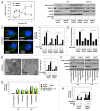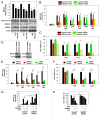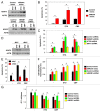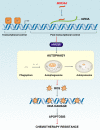MIR34A regulates autophagy and apoptosis by targeting HMGB1 in the retinoblastoma cell
- PMID: 24418846
- PMCID: PMC4077883
- DOI: 10.4161/auto.27418
MIR34A regulates autophagy and apoptosis by targeting HMGB1 in the retinoblastoma cell
Abstract
MIR34A (microRNA 34a) is a tumor suppressor gene, but how it regulates chemotherapy response and resistance is not completely understood. Here, we show that the microRNA MIR34A-dependent high mobility group box 1 (HMGB1) downregulation inhibits autophagy and enhances chemotherapy-induced apoptosis in the retinoblastoma cell. HMGB1 is a multifaceted protein with a key role in autophagy, a self-degradative, homeostatic process with a context-specific role in cancer. MIR34A inhibits HMGB1 expression through a direct MIR34A-binding site within the HMGB1 3' untranslated region. MIR34A inhibition of HMGB1 leads to a decrease in autophagy under starvation conditions or chemotherapy treatment. Inhibition of autophagy promotes oxidative injury and DNA damage and increases subsequent CASP3 activity, CASP3 cleavage, and PARP1 [poly (ADP-ribose) polymerase 1] cleavage, which are important to the apoptotic process. Finally, upregulation of MIR34A, knockdown of HMGB1, or inhibition of autophagy (e.g., knockdown of ATG5 and BECN1) restores chemosensitivity and enhances tumor cell death in the retinoblastoma cell. These data provide new insights into the mechanisms governing the regulation of HMGB1 expression by microRNA and their possible contribution to autophagy and drug resistance.
Keywords: Hmbg1; apoptosis; autophagy; chemotherapy; microRNA.
Figures






Similar articles
-
Poly-ADP-ribosylation of HMGB1 regulates TNFSF10/TRAIL resistance through autophagy.Autophagy. 2015;11(2):214-24. doi: 10.4161/15548627.2014.994400. Autophagy. 2015. PMID: 25607248 Free PMC article.
-
High-mobility group protein B1 silencing promotes susceptibility of retinoblastoma cells to chemotherapeutic drugs through downregulating nuclear factor-κB.Int J Mol Med. 2018 Mar;41(3):1651-1658. doi: 10.3892/ijmm.2018.3379. Epub 2018 Jan 10. Int J Mol Med. 2018. PMID: 29328447
-
Endogenous HMGB1 regulates autophagy.J Cell Biol. 2010 Sep 6;190(5):881-92. doi: 10.1083/jcb.200911078. J Cell Biol. 2010. PMID: 20819940 Free PMC article.
-
HMGB1 in the interplay between autophagy and apoptosis in cancer.Cancer Lett. 2024 Jan 28;581:216494. doi: 10.1016/j.canlet.2023.216494. Epub 2023 Nov 24. Cancer Lett. 2024. PMID: 38007142 Review.
-
High Mobility Group Box 1: An Immune-regulatory Protein.Curr Gene Ther. 2019;19(2):100-109. doi: 10.2174/1566523219666190621111604. Curr Gene Ther. 2019. PMID: 31223085 Review.
Cited by
-
MiR-15a and miR-16 induce autophagy and enhance chemosensitivity of Camptothecin.Cancer Biol Ther. 2015;16(6):941-8. doi: 10.1080/15384047.2015.1040963. Epub 2015 May 6. Cancer Biol Ther. 2015. PMID: 25945419 Free PMC article.
-
Autophagy and the pancreas: Healthy and disease states.Front Cell Dev Biol. 2024 Sep 24;12:1460616. doi: 10.3389/fcell.2024.1460616. eCollection 2024. Front Cell Dev Biol. 2024. PMID: 39381372 Free PMC article. Review.
-
microRNA-222-Mediated VHL Downregulation Facilitates Retinoblastoma Chemoresistance by Increasing HIF1α Expression.Invest Ophthalmol Vis Sci. 2020 Aug 3;61(10):9. doi: 10.1167/iovs.61.10.9. Invest Ophthalmol Vis Sci. 2020. PMID: 32756923 Free PMC article.
-
Silencing of circRNA.2837 Plays a Protective Role in Sciatic Nerve Injury by Sponging the miR-34 Family via Regulating Neuronal Autophagy.Mol Ther Nucleic Acids. 2018 Sep 7;12:718-729. doi: 10.1016/j.omtn.2018.07.011. Epub 2018 Jul 25. Mol Ther Nucleic Acids. 2018. PMID: 30098504 Free PMC article.
-
Downregulation of microRNA-224-3p Hampers Retinoblastoma Progression via Activation of the Hippo-YAP Signaling Pathway by Increasing LATS2.Invest Ophthalmol Vis Sci. 2020 Mar 9;61(3):32. doi: 10.1167/iovs.61.3.32. Invest Ophthalmol Vis Sci. 2020. PMID: 32186675 Free PMC article.
References
Publication types
MeSH terms
Substances
Grants and funding
LinkOut - more resources
Full Text Sources
Other Literature Sources
Research Materials
Miscellaneous
